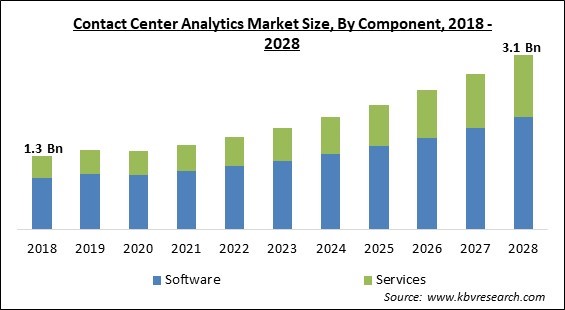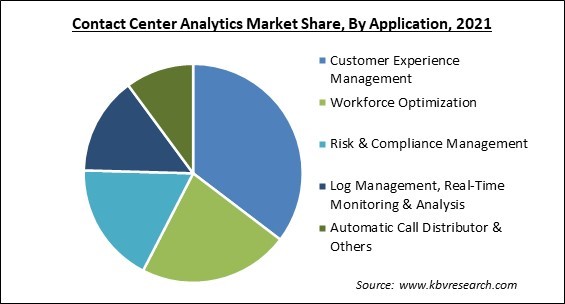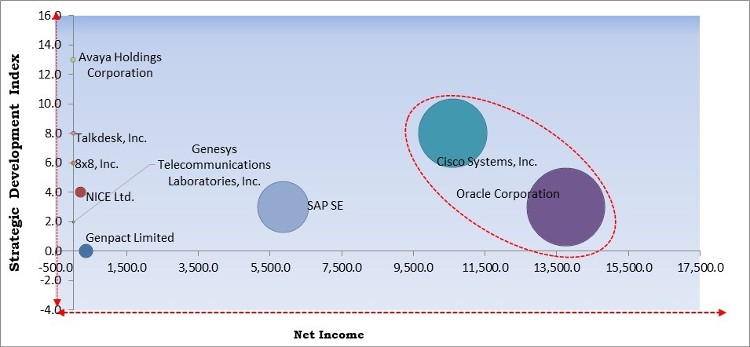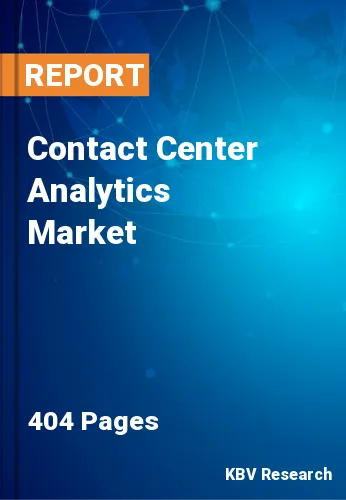The Global Contact Center Analytics Market size is expected to reach $3.1 billion by 2028, rising at a market growth of 11.2% CAGR during the forecast period.
The analysis of common contact center metrics to determine trends, causes, impacts, and outcomes are known as contact center analytics. Speech and text analytics, predictive analytics, customer analytics, and performance analytics are all part of it. The process of gathering and assessing customer data to uncover important insights about the service organization's performance is known as call center analytics. Customer satisfaction (CSAT), customer retention, revenue, customer effort score, and SLA performance are all factors that are considered in contact center analytics.
The gathering, measurement, as well as reporting of performance indicators within a contact center, is referred as call center analytics. It keeps track of inbound and outbound call data as well as agent performance. Handle time, customer satisfaction, call volume, and hold time are examples of common analytics. Call center analytics, on the other hand, is about much more than call times. It takes into account the human element to affect how calls are managed, as well as the overall customer experience.
Call center supervisors may usually get this information using specialist analytics tools. However, supervisors and team leaders frequently have access to call center data. Agents in more contemporary contact centers are given this real-time data so they can keep track of escalating call volumes. Call data, on the other hand, can help a user to create an excellent customer experience, increase brand loyalty, and enhance overall efficiency with the correct tools and approach.

The COVID-19 pandemic majorly impacted various businesses all over the world, due to which, the worldwide economy was significantly demolished. In addition, in order to regulate the spread of the COVID-19 infection, worldwide governments imposed lockdown in their countries. As a result of the lockdown enforcement, several companies and manufacturing went under a temporary closure, which hindered the production of various goods. Moreover, because of the stringent travel restrictions that were imposed by governments, the worldwide supply chain was also devastated which led to the shortage of various goods and intermediate goods.
Organizations incorporate their contact centers with rigorous software and analytics-based telephony technologies, like advanced analytics technologies (such as speech analytics and data analytics), real-time monitoring and analytics, and software such as ACDs, CTI, dialer APIs, and Voice over Internet Protocol (VoIP), as both contact centers' home working agents, as well as office agents, maintain inbound, outbound, and blended calls, emails, web inquiries, and chats. By quickly adjusting to evolving client preferences, these technologies assist firms in improving and speeding up their responsiveness and consistency. Software-based telephony technologies, on the other hand, enable call centers to communicate with customers via their computers rather than a traditional phone system.
Customers prefer to communicate with contact center personnel in real-time to get answers to their questions. However, the waiting and holding time involved in connecting with an agent degrades the entire consumer experience. Customer satisfaction is a key goal for the majority of businesses since client experience (CX) is critical to preserving customer connections. Organizations may improve customer experiences by using strong self-service bots and modern contact center technology like AI, ML, and analytics. These technologies also assisted call centers in dealing with the surge in calls that occurred during and after the COVID-19 outbreak.
Because they maintain such a large amount of sensitive consumer information, contact centers are at high risk of encountering significant issues in terms of data privacy and security. The number of fraud attempts against contact centers is rapidly surging to an alarming level, prompting businesses to respond with new solutions designed to detect fraudulent calls. According to the State of Call Center Authentication survey from 2018, more than 80% of respondents preferred a full authentication process before answering calls. When it comes to security considerations, call validation becomes critical. However, it has the potential to frustrate clients, resulting in a poor customer experience and low overall satisfaction.

Based on Component, the market is segmented into Software (Speech Analytics, Text Analytics, Desktop Analytics, Predictive Analytics, and Cross-channel Analytics & Performance Analytics) and Services. In 2021, the software segment acquired the largest revenue share of the contact center analytics market. The rising demand growth of this segment is attributed to the rising number of technological advancements in these software. Contact center analytics software, with the integration of streamlined technology, is becoming more simplified, allowing companies to easily operate them. Hence, the growth of this segment is surging.
Based on Application, the market is segmented into Customer Experience Management, Workforce Optimization, Risk & Compliance Management, Log Management, Real-Time Monitoring & Analysis, and Automatic Call Distributor & Others. In 2021, the workforce optimization segment garnered a significant revenue share of the contact center analytics market. The constantly surging growth of this segment is primarily attributed to an increasing focus of companies on the optimization of their workforce in order to obtain best results. Contact center analytics method help companies in keeping a track of the activities of their employees, which enables an optimized workforce. Therefore, the growth of this segment is bolstering.
Based on Deployment Mode, the market is segmented into Cloud and On-premise. In 2021, the Cloud segment registered the highest revenue share of the contact center analytics market. Because of the growing adoption of work-from-home models across contact centers around the world, demand for cloud-based contact center analytics has increased significantly. The cloud-based deployment approach is preferred by many organizations since it is totally hosted on a vendor's server and can only be accessed by authorized users. Software upgrades, as well as maintenance, are the responsibility of the vendor. Businesses can handle the operational and technical demands of their contact centers with the cloud-based deployment of the contact center.
Based on Organization Size, the market is segmented into Large Enterprises and Small & Medium Enterprises (SMEs). In 2021, the SMEs segment registered a substantial revenue share of the contact center analytics market. The increasing growth of the segment is owing to the rising efforts of these businesses to fulfill the demands of their customers. Customer expectations are continually rising and altering as new communication technologies and gadgets become more widely adopted. To address these issues, a number of SMEs are focused on implementing contact center analytics solutions to improve customer service. Additionally, the advantages of these solutions, such as the convenience of tracking client data, are propelling this market forward.
Based on Vertical, the market is segmented into BFSI, Retail & Consumer Goods, Energy & Utilities, Government & Defense, Healthcare & Life Sciences, Manufacturing, Telecom & IT, Travel & Hospitality, and Others. In 2021, the BFSI segment procured the largest revenue share of the contact center analytics market. BFSI firms are increasingly using advanced contact center solutions to better monitor, manage, and support remote workers in selling and receiving incentives on the basis of the sale of insurance and banking goods like credit cards and loans. These organizations can attract talent, obtain comprehensive visibility into whole customer care processes, and deliver rapid responses to client complaints and inquiries by installing contact center solutions, which is a major focus in the BFSI market.
| Report Attribute | Details |
|---|---|
| Market size value in 2021 | USD 1.5 Billion |
| Market size forecast in 2028 | USD 3.1 Billion |
| Base Year | 2021 |
| Historical Period | 2018 to 2020 |
| Forecast Period | 2022 to 2028 |
| Revenue Growth Rate | CAGR of 11.2% from 2022 to 2028 |
| Number of Pages | 404 |
| Number of Tables | 693 |
| Report coverage | Market Trends, Revenue Estimation and Forecast, Segmentation Analysis, Regional and Country Breakdown, Competitive Landscape, Companies Strategic Developments, Company Profiling |
| Segments covered | Component, Application, Deployment Mode, Organization Size, Vertical, Region |
| Country scope | US, Canada, Mexico, Germany, UK, France, Russia, Spain, Italy, China, Japan, India, South Korea, Singapore, Malaysia, Brazil, Argentina, UAE, Saudi Arabia, South Africa, Nigeria |
| Growth Drivers |
|
| Restraints |
|
Based on Regions, the market is segmented into North America, Europe, Asia Pacific, and Latin America, Middle East & Africa. In 2021, North America held the largest revenue share of the contact center analytics market. The rising technological improvements in the region are key factors fueling the growth of the regional contact center analytics market. Market growth is also likely to be aided by the rising number of contact center analytics market players across this region.
Free Valuable Insights: Global Contact Center Analytics Market size to reach USD 3.1 Billion by 2028

The major strategies followed by the market participants are Partnerships. Based on the Analysis presented in the Cardinal matrix; Cisco Systems, Inc. and Oracle Corporation are the forerunners in the Contact Center Analytics Market. Companies such as SAP SE, NICE Ltd. and Genesys Telecommunications Laboratories, Inc. are some of the key innovators in the Market.
The market research report covers the analysis of key stake holders of the market. Key companies profiled in the report include Oracle Corporation, Cisco Systems, Inc., Avaya Holdings Corporation, Genpact Limited, NICE Ltd., SAP SE, 8x8, Inc., Talkdesk, Inc., Genesys Telecommunications Laboratories, Inc., and CallMiner, Inc.
By Component
By Application
By Deployment Mode
By Organization Size
By Vertical
By Geography
The contact center analytics market size is projected to reach USD 3.1 billion by 2028.
Increasing adoption of technologies across contact centers are driving the market in coming years, however, data and security-related concerns growth of the market.
Oracle Corporation, Cisco Systems, Inc., Avaya Holdings Corporation, Genpact Limited, NICE Ltd., SAP SE, 8x8, Inc., Talkdesk, Inc., Genesys Telecommunications Laboratories, Inc., and CallMiner, Inc.
The Customer Experience Management segment acquired maximum revenue share in the Global Contact Center Analytics Market by Application in 2021; thereby, achieving a market value of $1.03 billion by 2028.
The Large Enterprises segment is leading the Global Contact Center Analytics Market by Organization Size in 2021, thereby, achieving a market value of $1.94 billion by 2028.
The North America market dominated the Global Contact Center Analytics Market by Region in 2021, and would continue to be a dominant market till 2028; thereby, achieving a market value of $1.04 billion by 2028.
Our team of dedicated experts can provide you with attractive expansion opportunities for your business.

